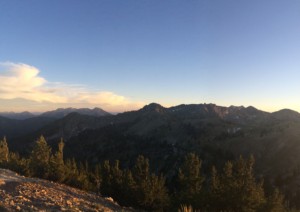By Ian Summers for EDRBlog.org

Litigation over public land management has become a contentious topic in recent news. Industry groups and ranchers are pressuring the new Congress and Administration to end what they deem “abusive” litigation tactics used by environmental groups against grazing and other federal land projects involving the private sector. It’s within this context that the webinar Land Management Conflict: Litigation and the Future of Alternative Dispute Resolution was held under the Western Governors’ National Forest and Rangeland Initiative, providing a thought-provoking session on the role of litigation and collaboration in addressing tensions over public lands.
Moderated by David Dreher of Foresight LLC, the webinar shared a wide range of perspectives from the U.S. Forest Service, environmental advocacy groups, and the forestry industry. Despite the array of opinions shared by these stakeholders, there was a clear consensus on a few main points. First, the speakers agreed that environmental lawsuits no longer focus on “big picture” issues, such as the scale and nature of federal oversight; rather, the majority of litigation is now in regards to whether due process has been followed. Second, most panelists agreed that the rights of people to access the courts and sue is necessary in our democracy and therefore should be protected. Finally, and perhaps most importantly, all speakers agreed that up-front collaboration with local stakeholders is a better approach for formulating land management policy than is trying to resolve disagreements and conflict through the courts.
Get notified when new articles are posted to the EDR blog – sign up for our email list »
Unfortunately, the webinar did not go into much detail as to how to create more collaboration. This might be because litigation and collaboration were frequently presented as mutually exclusive: the speakers noted that upfront collaboration can oftentimes head off litigation around land management efforts, but that litigation also tends to be an impediment to more collaboration. For example, panelist Jim Riley of Riley and Associates asserted that the threat of being swept up in a lawsuit was an obstacle to collaboration on projects in Montana. While this can be true in some specific cases, we have to be careful about using such a stark dichotomy for several reasons. First, multiple panelists noted there is no “foolproof” way to lessen litigation without entering potentially dangerous territory of precluding groups from being able to access the courts. The standoffs at Malheur National Wildlife Refuge and Standing Rock are examples of the extreme measures groups will take if they believe the legal system is stacked against them. As such, raising the threshold for litigation, limiting standing, or moving lawsuits into arbitration will only ensure there is even less future cooperation, not more. Additionally, the incentive for collaboration should be to have multiple stakeholders involved to solve problems locally, not legal expedience. Finally, the threat of litigation is often the “stick” that gets people to come to the table to negotiate and collaborate.
I argue that litigation and the lack of collaboration are both symptomatic of our polarized society, with communities holding radically different visions for public lands use. Under this approach, litigation should not be viewed as a failure of the system; instead, lawsuits are an important tool for ensuring all interested groups have legal recourse. Litigation can also provide a strong incentive for all parties to follow processes as spelled out under the law. That said, litigation can be contentious, emotional, and leave permanent divides between stakeholders, and therefore should not be the default approach for addressing conflicts over public lands.
As such, we need to realize that the goal isn’t collaboration for collaboration’s sake. Instead, the goal is to find more ways for all interested parties to be heard, to consider each other’s interests, and to find workable solutions that can gain widespread buy in. The Federal Land Policy and Management Act (FLPMA) and other federal directives are designed to encourage stakeholder engagement and public participation, and programs such as the Collaborative Forest Landscape Restoration Program have been hailed for their effectiveness in fostering collaborative approaches to public land management. Yet, more needs to be done. Congress and federal land management agencies need to find ways to foster up-front collaboration before undertaking projects and plan updates, so as to encourage all stakeholders to meaningfully work together on issues related to public lands management. Creating a space for open and honest dialogue and interest-based negotiation can provide all involved groups a sense of involvement and room to collectively problem-solve, thereby lessening the need for costly and complex lawsuits. At the same time, we need to keep in mind that litigation may still have an important role, and federal courts should be working towards expeditious resolution and streamline the legal process wherever possible—without making it harder to sue.
As pointed out during the webinar by panelist Susan Jane Brown of the Western Environmental Law Center, we need to focus on the problems we are trying to solve. The goal shouldn’t be to simply reduce litigation or to engage in collaboration for collaboration’s sake; rather, the goal should be to craft policies and management strategies that conserve federal land, support the wellbeing of rural communities, and promote cooperation between local stakeholders. To accomplish this, both collaboration and litigation are necessary.
 Bio
Bio
Ian Summers is a Ph.D. student in the Department of Communication and Graduate Research Fellow at the University of Utah. He is a recipient of the Floyd O’Neil Fellowship from the American West Center and the David C. Williams Memorial Fellowship from the College of Social and Behavioral Science. His dissertation research studies how militias and indigenous communities publicly contest federal land management mandates.
